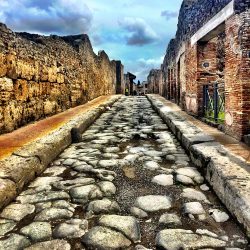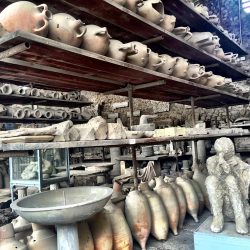 Last Summer I spent a weekend in this stunning part of Southern Italy, and I fell in love with it! Although not far from Puglia, the region where I live (a mere 3 and a half hours drive), I barely knew the area. I had visited it once with my parents when I was a kid, but I didn’t have much memory of it: it was such a surprise to discover how beautiful it is! I slept in Maiori, the perfect starting point for many different day trips around along Amalfi Coast.
First of all, where is that? Amalfi Coast is so called after the name of one of its best known towns, Amalfi. It is a stretch of coastline about 50-kilometers long in Campania region (the most famous city of it being Napoli, or Naples). It runs from Vietri sul Mare, a picturesque town worldwide famous for its ceramics, up to Meta, hilltop village just outside Sorrento. Amalfi Coast runs at the base of the Lattari mountains, which makes the view of the coastline very dramatic.
Driving through the so – called “road of 1,000 bends” is an experience itself. Very tortuous, the road passes through lemon terraces (being the lemon the most characteristic fruit of the area, well known for the limoncello productions) and traditional villages. The road is so narrow that during summer months traffic jams are inevitable! For this reason, if driving is not your favorite thing, you should probably avoid to drive on this road, preferring to take one of the buses that link the coast. It will also be a pleasant way to enjoy the stunning cliffs on one side and the astonishing azure sea on the other.
Last Summer I spent a weekend in this stunning part of Southern Italy, and I fell in love with it! Although not far from Puglia, the region where I live (a mere 3 and a half hours drive), I barely knew the area. I had visited it once with my parents when I was a kid, but I didn’t have much memory of it: it was such a surprise to discover how beautiful it is! I slept in Maiori, the perfect starting point for many different day trips around along Amalfi Coast.
First of all, where is that? Amalfi Coast is so called after the name of one of its best known towns, Amalfi. It is a stretch of coastline about 50-kilometers long in Campania region (the most famous city of it being Napoli, or Naples). It runs from Vietri sul Mare, a picturesque town worldwide famous for its ceramics, up to Meta, hilltop village just outside Sorrento. Amalfi Coast runs at the base of the Lattari mountains, which makes the view of the coastline very dramatic.
Driving through the so – called “road of 1,000 bends” is an experience itself. Very tortuous, the road passes through lemon terraces (being the lemon the most characteristic fruit of the area, well known for the limoncello productions) and traditional villages. The road is so narrow that during summer months traffic jams are inevitable! For this reason, if driving is not your favorite thing, you should probably avoid to drive on this road, preferring to take one of the buses that link the coast. It will also be a pleasant way to enjoy the stunning cliffs on one side and the astonishing azure sea on the other.
By Sergio Scardia – Full Story at The Scruffy Italian Traveler
]]>

 My day took me from my base at Grand Hotel Excelsior Vittoria in Sorrento, all the way to Ravello and back along the stunning panoramic road of the Amalfi Coast, with stops in Amalfi, Praiano and Positano. From the distance, I was also able to catch a view of Maiori and Minori, and drive by Atrani, which I thought I was very charismatic.
My day took me from my base at Grand Hotel Excelsior Vittoria in Sorrento, all the way to Ravello and back along the stunning panoramic road of the Amalfi Coast, with stops in Amalfi, Praiano and Positano. From the distance, I was also able to catch a view of Maiori and Minori, and drive by Atrani, which I thought I was very charismatic.


 Pompeii, along with Herculaneum and many villas in the surrounding area, was mostly destroyed and buried under 13 to 20 ft of volcanic ash in the eruption of Mount Vesuvius in AD 79.
Pompeii, along with Herculaneum and many villas in the surrounding area, was mostly destroyed and buried under 13 to 20 ft of volcanic ash in the eruption of Mount Vesuvius in AD 79.


 Irpinia contradicts everything you expect about Southern Italy. The rainy climate and green mountains have more in common with the Pacific Northwest than the Amalfi Coast, just 40 miles away. Instead of Roman ruins like those at Pompeii, stones remain from the Osci, the native Campanian tribe known for their salacious festivals. The spiritual center of the region is the famously hard-to-reach church at Montevergine.
Pilgrims arrive after long bus rides over highways that span seemingly bottomless gorges. Irpinia’s landscape is foreboding, which is why the Montevergine pilgrimage has always required strong and focused devotion. The thin air is hard to breathe. The damp stone from the mountain’s peaks perfume the air with ancient minerals.
In the cleared piazza, old women sell candles and chestnuts, but the attention belongs to the crowds of dancing men and women beating tambourines and clapping out ancient rhythms with castanets. If you took away the down coats and wool hats, the scene would look like it inspired one of the ancient mosaics on display at the archaeological museum in nearby Naples.
Energy builds among the devotees who pray and sing as the faithful have done here since the thirteenth century. But on February 2nd devotees wear lipstick and stubble and feather boas. By the time night descends, over two thousand gay, lesbian, bisexual and transgender pilgrims will have passed through this Catholic shrine to worship the icon they call the ‘Madonna of Transformation.’
Irpinia contradicts everything you expect about Southern Italy. The rainy climate and green mountains have more in common with the Pacific Northwest than the Amalfi Coast, just 40 miles away. Instead of Roman ruins like those at Pompeii, stones remain from the Osci, the native Campanian tribe known for their salacious festivals. The spiritual center of the region is the famously hard-to-reach church at Montevergine.
Pilgrims arrive after long bus rides over highways that span seemingly bottomless gorges. Irpinia’s landscape is foreboding, which is why the Montevergine pilgrimage has always required strong and focused devotion. The thin air is hard to breathe. The damp stone from the mountain’s peaks perfume the air with ancient minerals.
In the cleared piazza, old women sell candles and chestnuts, but the attention belongs to the crowds of dancing men and women beating tambourines and clapping out ancient rhythms with castanets. If you took away the down coats and wool hats, the scene would look like it inspired one of the ancient mosaics on display at the archaeological museum in nearby Naples.
Energy builds among the devotees who pray and sing as the faithful have done here since the thirteenth century. But on February 2nd devotees wear lipstick and stubble and feather boas. By the time night descends, over two thousand gay, lesbian, bisexual and transgender pilgrims will have passed through this Catholic shrine to worship the icon they call the ‘Madonna of Transformation.’